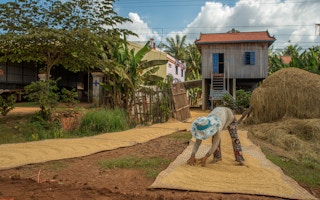The rapid rise of tiny loans aimed at helping poor Cambodians has led to more debt, with many borrowers forced to sell land, migrate or put their children to work, human rights groups said on Wednesday.
The Southeast Asian nation has about 2.4 million borrowers with $5.4 billion in outstanding microloans, and among the world’s biggest average loan sizes, according to a report from human rights groups Licadho and Sahmakum Teang Tnaut (STT).
High interest rates, the use of land titles as collateral, and pressure to repay loans have led to a “predatory form of lending” by microfinance institutions (MFIs), they said.
“MFIs, as they currently operate, pose a direct threat to the land tenure security of millions of people in Cambodia,” they said in the report.
“In most cases, the land that was lost was income-generating. Loss of land therefore jeopardises a family’s livelihood and identity.”
The National Bank of Cambodia did not respond to emails seeking comment.
An official at industry group the Cambodia Microfinance Association (CMA) said all members followed the law, as well as CMA’s lending guidelines to check over-indebtedness.
“CMA and other stakeholders watch the growth in the sector carefully and take appropriate measures to ensure long-term sustainable growth,” acting executive director Chea Saren said.
Microfinance took off in Cambodia in the 1990s as a way to provide easier access to credit for those left impoverished after decades of war, allowing many to purchase farming equipment or set up small businesses.
After the government introduced more formal microfinance policies in 2007, outstanding loans more than quadrupled to $1.3 billion in 2013 from just $300 million in 2009, data compiled by Licadho and STT showed.
At the end of 2018, average loan size was about $3,370, more than twice the country’s gross domestic product per capita of $1,384 in 2017.
The World Bank, in a report earlier this year, warned of risks to the Cambodian economy from bigger microloans. In 2017, the United Nations said that “for many Cambodians, microfinance loans only serve to push borrowers further into poverty”.
Cambodia imposed an annual interest-rate cap of 18 percent on MFIs in 2017. But that had proven “ineffective” in slowing credit growth, Licadho and STT said.
“
Collateralised credit is most risky when it is given to people who are already at the margins of economic vulnerability
Nathan Green, researcher, University of Wisconsin
The impoverished Southeast Asian country of 16 million has struggled to establish land ownership since the deadly Khmer Rouge destroyed all property records to establish a form of communism in the 1970s.
Over the last two decades, the government has driven efforts to title land to help alleviate poverty.
About half of MFI loans in Cambodia are secured by land titles, according to Licadho and STT.
“Collateralised credit is most risky when it is given to people who are already at the margins of economic vulnerability,” said Nathan Green at the University of Wisconsin who is researching microfinance in Cambodia.
“It is especially risky in Cambodia because the microfinance market is already saturated, and because there is almost no government oversight,” he told the Thomson Reuters Foundation.
About 10-15 per cent of land held by Cambodian farmers has been lost due to failure to repay microloans, according to Milford Bateman, a professor of development studies at Saint Mary’s University in Canada, who has studied microfinance.
This story was published with permission from Thomson Reuters Foundation, the charitable arm of Thomson Reuters, that covers humanitarian news, climate change, resilience, women’s rights, trafficking and property rights. Visit http://news.trust.org/climate.










